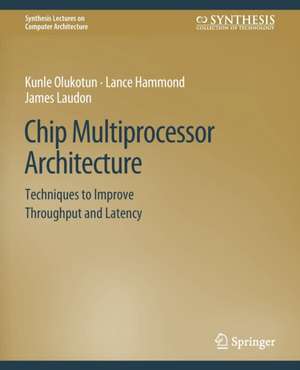Chip Multiprocessor Architecture: Techniques to Improve Throughput and Latency: Synthesis Lectures on Computer Architecture
Autor Kunle Olukotun, Lance Hammond, James Laudonen Limba Engleză Paperback – 31 dec 2007
Din seria Synthesis Lectures on Computer Architecture
-
 Preț: 359.05 lei
Preț: 359.05 lei - 18%
 Preț: 690.24 lei
Preț: 690.24 lei - 20%
 Preț: 281.76 lei
Preț: 281.76 lei -
 Preț: 453.85 lei
Preț: 453.85 lei -
 Preț: 226.98 lei
Preț: 226.98 lei -
 Preț: 388.52 lei
Preț: 388.52 lei -
 Preț: 353.79 lei
Preț: 353.79 lei -
 Preț: 481.05 lei
Preț: 481.05 lei -
 Preț: 261.32 lei
Preț: 261.32 lei -
 Preț: 413.27 lei
Preț: 413.27 lei -
 Preț: 494.18 lei
Preț: 494.18 lei -
 Preț: 260.56 lei
Preț: 260.56 lei -
 Preț: 194.92 lei
Preț: 194.92 lei -
 Preț: 450.11 lei
Preț: 450.11 lei -
 Preț: 319.21 lei
Preț: 319.21 lei -
 Preț: 449.53 lei
Preț: 449.53 lei -
 Preț: 264.41 lei
Preț: 264.41 lei -
 Preț: 418.07 lei
Preț: 418.07 lei -
 Preț: 386.22 lei
Preț: 386.22 lei -
 Preț: 486.98 lei
Preț: 486.98 lei -
 Preț: 264.20 lei
Preț: 264.20 lei -
 Preț: 383.71 lei
Preț: 383.71 lei -
 Preț: 346.86 lei
Preț: 346.86 lei -
 Preț: 265.18 lei
Preț: 265.18 lei -
 Preț: 323.45 lei
Preț: 323.45 lei -
 Preț: 260.18 lei
Preț: 260.18 lei -
 Preț: 191.48 lei
Preț: 191.48 lei -
 Preț: 206.29 lei
Preț: 206.29 lei -
 Preț: 205.92 lei
Preț: 205.92 lei -
 Preț: 205.70 lei
Preț: 205.70 lei -
 Preț: 207.06 lei
Preț: 207.06 lei -
 Preț: 260.95 lei
Preț: 260.95 lei -
 Preț: 261.91 lei
Preț: 261.91 lei -
 Preț: 192.63 lei
Preț: 192.63 lei -
 Preț: 262.09 lei
Preț: 262.09 lei -
 Preț: 259.41 lei
Preț: 259.41 lei -
 Preț: 260.95 lei
Preț: 260.95 lei -
 Preț: 456.66 lei
Preț: 456.66 lei -
 Preț: 261.53 lei
Preț: 261.53 lei -
 Preț: 486.42 lei
Preț: 486.42 lei -
 Preț: 210.55 lei
Preț: 210.55 lei -
 Preț: 387.58 lei
Preț: 387.58 lei -
 Preț: 448.38 lei
Preț: 448.38 lei -
 Preț: 262.68 lei
Preț: 262.68 lei -
 Preț: 263.06 lei
Preț: 263.06 lei - 20%
 Preț: 288.91 lei
Preț: 288.91 lei -
 Preț: 260.95 lei
Preț: 260.95 lei -
 Preț: 313.82 lei
Preț: 313.82 lei
Preț: 264.20 lei
Nou
Puncte Express: 396
Preț estimativ în valută:
50.56€ • 52.59$ • 41.74£
50.56€ • 52.59$ • 41.74£
Carte tipărită la comandă
Livrare economică 15-29 aprilie
Preluare comenzi: 021 569.72.76
Specificații
ISBN-13: 9783031005923
ISBN-10: 3031005929
Ilustrații: VIII, 145 p.
Dimensiuni: 191 x 235 mm
Greutate: 0.28 kg
Editura: Springer International Publishing
Colecția Springer
Seria Synthesis Lectures on Computer Architecture
Locul publicării:Cham, Switzerland
ISBN-10: 3031005929
Ilustrații: VIII, 145 p.
Dimensiuni: 191 x 235 mm
Greutate: 0.28 kg
Editura: Springer International Publishing
Colecția Springer
Seria Synthesis Lectures on Computer Architecture
Locul publicării:Cham, Switzerland
Cuprins
Contents: The Case for CMPs.- Improving Throughput.- Improving Latency Automatically.- Improving Latency using Manual Parallel Programming.- A Multicore World: The Future of CMPs.
Notă biografică
Kunle Olukotun is a Professor of Electrical Engineering and Computer Science at Stanford University. Olukotun led the Stanford Hydra project which developed the first chip multiprocessor (multicore chip) with support for thread-level speculation. Using insights gained from the Hydra project, Olukotun founded Afara Websystems to demonstrate the benefits of chip multiprocessor technology for high-throughput, low power server systems. Afara microprocessor technology, called Niagara, was acquired by Sun Microsystems. The Niagara based Sun Fire CoolThreads servers have become one of Sun’s fastest ramping products ever. Olukotun is actively involved in research in computer architecture, parallel programming environments and scalable parallel systems. Currently, Olukotun directs the Stanford Pervasive Parallelism Lab (PPL) which seeks to proliferate the use of parallelism in all application areas. Olukotun is a Fellow of the ACM. Olukotun received his Ph.D. in Computer Engineering from TheUniversity of Michigan. James Laudon is a Distinguished Engineer with Sun Microsystems. His areas of expertise include multithreading, multiprocessors, and performance modelling. He is currently focused on the architecture of future generations in the UltraSPARC T1 chip multiprocessor line. James joined Sun in July of 2002 through the acquisition of Afara Websystems.
